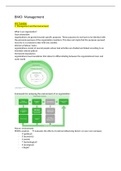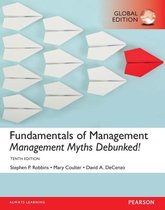BMO- Management
W1 Tuesday
1: Management and the Environment
What is an organization?
Goal orientation:
organizations are geared towards specific purposes. These purposes do not have to be identical with
the personal purposes of the organization members. This does not imply that the purposes pursued
must be in a consistent order with one another.
Division of labour/ tasks:
organizations consist of several people whose task activities are divided and linked according to an
intended rational pattern
Permanent boundaries:
organizations have boundaries that allow for differentiating between the organizational inner and
outer world
Framework for analysing the environment of an organization:
Macro- environment:
PESTEL-analysis: evaluates the effects of external influencing factors on your own company
- P (political)
- E (economic)
- S (social)
- T (technological)
- E (ecological)
- L (legal)
,External/ macro-environment refers to factors, forces, situations and events outside the
organisation that affects it performance. (Includes these components:)
Economic: interest rates, inflation, employment/unemployment rates, disposable income
levels, stock market fluctuations and business cycle stages
Demographic: trends in population characteristics such as age, race, gender, education level,
geographic location and family composition
Technological: scientific or industrial innovations
Sociocultural: societal and cultural factors such as values, attitudes, trends, traditions,
lifestyles, beliefs, tastes and patterns of behaviour
Political/legal: federal, state and local laws, as well as laws of other countries and global
laws. Also includes a country’s political conditions and stability
Global: encompasses those issues associated with globalization and a world economy
(volcano eruption, political instability, terrorist attack, etc.)
Porters 5-forces analysis:
SWOT- analysis connecting the environment and the firm
Stakeholders: are all actors that have an interest in the organization and can either affect or be
affected by its goals, decisions and actions
(shareholders: aandeelhouders)
, Stakeholder-management steps:
1. Identifying stakeholders and their interests
2. Evaluating stakeholders and their importance
3. Implementing measures towards specific
stakeholder groups and single stakeholders
To whom do companies feel mainly
responsible: employees, shareholders,
customers
SWOT-analysis leads to internal decision making
2: Organisational decision-making and managing change
Decision making
Problem: is a gap between existing and desired state a problem is subjective, not everyone sees
something as a problem
Problem identification: comparison between current reality and some standard (e.g.: past
performance, previously set goals)
Decision making process:
1. Identifying problem compare current reality and desired state
2. Identifying criteria factors that are relevant for the decision (e.g.: cost, time, risk)
3. Weighting criteria
4. Developing alternatives list alternatives that could solve the problem
5. Analysing alternatives compare with previously set criteria and weights
6. Selecting alternatives Choose alternatives that are most likely to solve the problem
7. Implementing alternatives put decision in action, who is affected and are they
committed?
8. Evaluating outcome reflect, was the desired result achieved?
Common decision-making errors and bias:
- Overconfidence: unrealistically positive views of yourself
- Immediate gratification: wanting immediate rewards
- Anchoring effect: fixate on initial information – fail to adjust to new info later
- Selective perception: seeing what you want to see – ignoring opposing views






